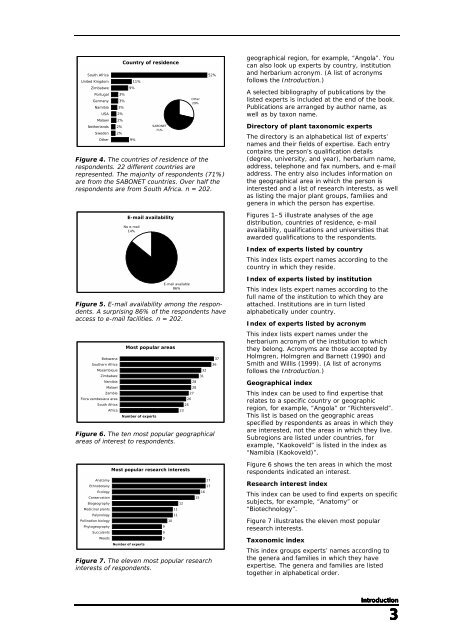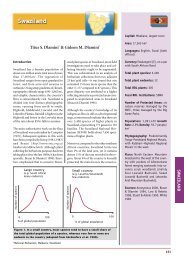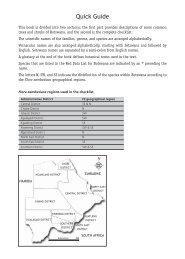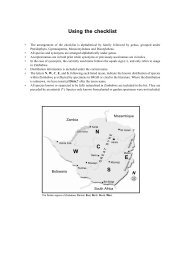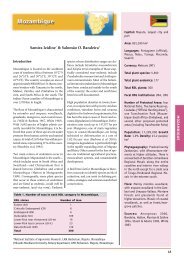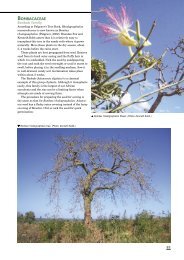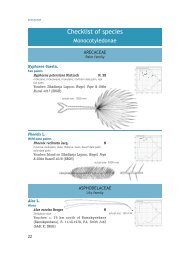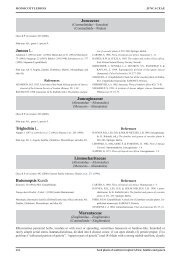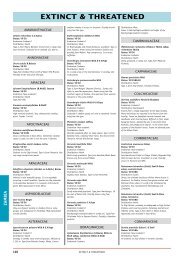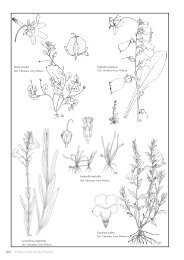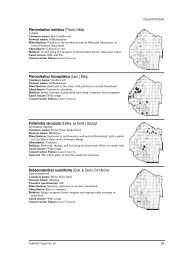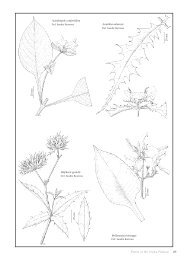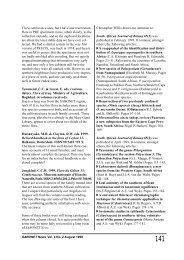Plant taxonomic expertise - SABONET
Plant taxonomic expertise - SABONET
Plant taxonomic expertise - SABONET
Create successful ePaper yourself
Turn your PDF publications into a flip-book with our unique Google optimized e-Paper software.
South Africa<br />
United Kingdom<br />
Zimbabwe<br />
Portugal<br />
Germany<br />
Namibia<br />
USA<br />
Malawi<br />
Netherlands<br />
Sweden<br />
Other<br />
Figure 4. The countries of residence of the<br />
respondents. 22 different countries are<br />
represented. The majority of respondents (71%)<br />
are from the <strong>SABONET</strong> countries. Over half the<br />
respondents are from South Africa. n = 202.<br />
E-mail availability<br />
No e-mail<br />
14%<br />
E-mail available<br />
86%<br />
Figure 5. E-mail availability among the respondents.<br />
A surprising 86% of the respondents have<br />
access to e-mail facilities. n = 202.<br />
Botswana<br />
Southern Africa<br />
Mozambique<br />
Zimbabwe<br />
Namibia<br />
Malawi<br />
Zambia<br />
Flora zambesiaca area<br />
South Africa<br />
Africa<br />
Most popular areas<br />
Number of experts<br />
32<br />
31<br />
28<br />
28<br />
27<br />
26<br />
25<br />
23<br />
Figure 6. The ten most popular geographical<br />
areas of interest to respondents.<br />
Anatomy<br />
Ethnobotany<br />
Ecology<br />
Conservation<br />
Biogeography<br />
Medicinal plants<br />
Palynology<br />
Pollination biology<br />
Phytogeography<br />
Succulents<br />
Weeds<br />
3%<br />
3%<br />
3%<br />
2%<br />
2%<br />
2%<br />
2%<br />
Country of residence<br />
9%<br />
11%<br />
9%<br />
Most popular research interests<br />
Number of experts<br />
<strong>SABONET</strong><br />
71%<br />
10<br />
9<br />
9<br />
9<br />
Figure 7. The eleven most popular research<br />
interests of respondents.<br />
11<br />
11<br />
12<br />
Other<br />
29%<br />
15<br />
16<br />
52%<br />
17<br />
17<br />
36<br />
37<br />
geographical region, for example, “Angola”. You<br />
can also look up experts by country, institution<br />
and herbarium acronym. (A list of acronyms<br />
follows the Introduction.)<br />
A selected bibliography of publications by the<br />
listed experts is included at the end of the book.<br />
Publications are arranged by author name, as<br />
well as by taxon name.<br />
Directory of plant <strong>taxonomic</strong> experts<br />
The directory is an alphabetical list of experts’<br />
names and their fields of <strong>expertise</strong>. Each entry<br />
contains the person’s qualification details<br />
(degree, university, and year), herbarium name,<br />
address, telephone and fax numbers, and e-mail<br />
address. The entry also includes information on<br />
the geographical area in which the person is<br />
interested and a list of research interests, as well<br />
as listing the major plant groups, families and<br />
genera in which the person has <strong>expertise</strong>.<br />
Figures 1–5 illustrate analyses of the age<br />
distribution, countries of residence, e-mail<br />
availability, qualifications and universities that<br />
awarded qualifications to the respondents.<br />
Index of experts listed by country<br />
This index lists expert names according to the<br />
country in which they reside.<br />
Index of experts listed by institution<br />
This index lists expert names according to the<br />
full name of the institution to which they are<br />
attached. Institutions are in turn listed<br />
alphabetically under country.<br />
Index of experts listed by acronym<br />
This index lists expert names under the<br />
herbarium acronym of the institution to which<br />
they belong. Acronyms are those accepted by<br />
Holmgren, Holmgren and Barnett (1990) and<br />
Smith and Willis (1999). (A list of acronyms<br />
follows the Introduction.)<br />
Geographical index<br />
This index can be used to find <strong>expertise</strong> that<br />
relates to a specific country or geographic<br />
region, for example, “Angola” or “Richtersveld”.<br />
This list is based on the geographic areas<br />
specified by respondents as areas in which they<br />
are interested, not the areas in which they live.<br />
Subregions are listed under countries, for<br />
example, “Kaokoveld” is listed in the index as<br />
“Namibia (Kaokoveld)”.<br />
Figure 6 shows the ten areas in which the most<br />
respondents indicated an interest.<br />
Research interest index<br />
This index can be used to find experts on specific<br />
subjects, for example, “Anatomy” or<br />
“Biotechnology”.<br />
Figure 7 illustrates the eleven most popular<br />
research interests.<br />
Taxonomic index<br />
This index groups experts’ names according to<br />
the genera and families in which they have<br />
<strong>expertise</strong>. The genera and families are listed<br />
together in alphabetical order.<br />
Introduction<br />
Introduction<br />
3


